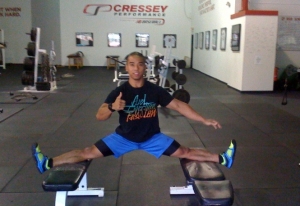…if you’re already flexible.
Now how do you know if you are “flexible”? There are relative measures, such as being able to lick your elbow (I can sort of do it!), touching your toes, and doing really well in yoga class.

To take it to the textbook definition, we can perform the Beighton Laxity Test and see how well we do on it to determine our “flexibility” levels.
Charlie Weingroff elaborates the test:
1. Extend the first finger (2nd digit) over the back of the hand—if 90 degrees or greater score:
1 point left
1 point right2. Flex the thumb toward the forearm—if the thumb touches the forearm
Score:
1 point left
1 point right3. Extend the arm—if 10 degrees or more of hyperextension at the elbow
Score:
1 point left
1 point right4. Extend the leg—if 10 degrees or more of hyperextension at the knee
Score:
1 point left
1 point right5. Flex at the waist—if you are able to touch your palms to the floor score:
1 pointTotal your points and compare below:
1-3 points—low flexibility
4-6 points—moderate flexibility
7-9 points—high flexibility
So what causes dancers (and other athletes) that score well on this test to be so flexible? It basically comes down to a genetic defect in which they are unable to absorb collagen effectively. In reality, the statistics show that there may only be roughly 10-20% of the population to have congenital laxity, with roughly 30% of said population being Arab, Asian, and African American populations that are actually lax.
So there may be some validity to this mother’s ranting after all…
[youtube http://www.youtube.com/watch?v=yMfihId30ME&]
.
You’ve Determined You’re NOT Hypermobile – Now What?
Why do we feel the need to “stretch”? Someone brought up a great question at the recent Cressey Performance Fall Seminar 2012 – If the athlete feels “tight” in one area, their rationale for stretching is to elongate or static stretch the muscle bed in order to alleviate the tightness. If the athlete has truly “short” tissue quality, then it might be possible that they will need some sort of stretching to alleviate the tightness feeling. On the other hand, if the athlete has “stiff” tissue quality (muscles), then perhaps we can attack it with a different methodology – foam rolling, aggressive soft tissue work done by an LMT or other methodologies, etc. in order to get rid of that “tightness” feeling.
EC goes over better protocols for flexibility training protocols HERE, and Mike Robertson, owner and strength coach of IFAST, goes over basic static stretching as an athlete (or in our cases, a dancer) Q&A HERE.
According to Eric Cressey, we do not need to constantly crank on our hamstrings and adductors to get out of that “tight” sensation. In reality, we should be looking to improve tissue quality in order to fully take advantage of our lack of length.
You’ve Determined You ARE Hypermobile – Now What?
Don’t stretch. At least, in the areas that don’t need static stretching. If you can do full on splits, there may be enough evidence in this post to justify why you don’t need to stretch your hamstrings and adductors as much as someone in the above category. Doing yoga every other day may feel great mentally, but it might not be a great use of your time if you don’t even need to stretch to begin with. I’ll be honest – I myself am hypermobile (9/9 on the Beighton Laxity Score Test), and I haven’t legitimately practiced a full-on split in who knows how long (probably 3+ years).

I’ve been hammering away – almost everyday really – on my tissue quality as a whole. I’ve always prided myself on my ability to stay nimble, and figures that I was just genetically predispositioned towards being hypermobile anyway! And in the above picture, I just popped into the split relatively easily with literally no prior practice (just some pre-workout foam rolling), much like how any other gent can throw 225 on the bench and go for reps.
So what else can we do instead of stretching? According to Robertson, we can do several things. Namely, performing different stability exercises such as EQIs, which are a form of eccentric stretching, along with performing different dynamic exercises – both of which can draw mobility and stability at the same time, such as this 3 Point Extension Rotation.
[youtube http://www.youtube.com/watch?v=0VidATyRHS4&]
.
Further, Cressey has claimed that in order to fully appreciate and take advantage of our hypermobility, we must counterbalance that with hyperstability, or rather stability to match the demands of the extreme levels of mobility found in our joints and ligaments. Anecdotally speaking, I can pop my shoulder out anteriorly on demand, and while that may seem totally disgusting to some, to others such as myself, I thought it was completely normal my whole childhood.
What can I do to counteract the anterior migration of my glenohumeral joint (my shoulder)? I can make sure my back muscles (traps, rhomboids, scap muscles) are in working order in order to counteract such hypermobility. That, and making sure I have proper posture for most things – imagine a slouched posture, on top of having a loose shoulder that can pop out in the front. How much worse will that be for someone who is already set in their ways (aka older), sits in front of their computer, doesn’t perform the proper exercises, and complains of anterior shoulder pain (and doesn’t know that they are flexible)?

So what are some solutions to this level of hypermobility? For starters, we can avoid stretches, exercises, or poses that crank us into extreme extension or degrees of movement. Yes – this means you bboys and bgirls. If you’d like to avoid that back pain, then guess what? Stop doing your hollowbacks so damn extreme! Rather, replace them with a different freeze (preferably a joint stacked freeze; that is, unless you want to get injured during your bboying career).
Or for those who do yoga, yet complain of back pain… guess what! STOP DOING YOGA. (First time I’ve used all caps on this blog – it’s worth it.) At least, stop doing the type of yoga that cranks you into insane poses like the first picture of this blogpost does.
After avoiding the obvious, we can begin to increase our stability by performing various exercises and warm-ups that encourage stability and strength throughout the movement: ranging from prone bridges and supine bridges, to rack pulls and farmer’s walks. The former encourage stability in a proximal to distal manner, while rack pulls and farmer’s walks encourage stability in a dynamic fashion (approximation and stability during a movement, specifically.)
[youtube http://www.youtube.com/watch?v=edjFdJY3vIU]
.
Long story short, if you’ve scored well on the above laxity test, avoid stretching and use that time to foam roll, do other stability inducing exercises, or do some kettlebell swings while watching the Walking Dead.

If you’ve scored poorly on this test, and/or you truly have “short” tissue quality in many of your muscles, then pursue stretching (generally speaking of course! – I believe foam rolling + dynamic stretching will provide more benefit than static stretching – but that is another story for another time).
If you or your friends have congenital laxity, please pass this on by sharing, liking or commenting below!!! Thank you and remember:


